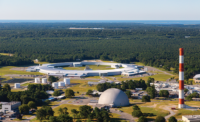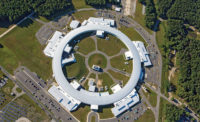PROJECT COST: $172 million
The light will soon shine faster and brighter at the U.S. Department of Energy's Brookhaven National Laboratory on Long Island, thanks to a multi-phased project to create a new 3 billion electron-volt energy storage ring that will generate X-rays and other types of light 10,000 times more intense than the current facilities.

A 278,000-sq-ft, 1,000-ft-dia ring structure at the heart of the new National Synchrotron Light Source II facility is already taking shape at the lab in Upton, N.Y. Construction began in May 2009 and is set to continue in phases through 2012, when technicians will begin their own equipment installation and commissioning process running through 2014.
The project got a boost last year from $150 million in federal stimulus monies, some of which is funding the $172 million contract for the ring structure and adjoining buildings. Torcon of Red Bank, N.J. is construction manager on that contract, which has already let nearly all of its subcontract awards. A second contract estimated at $40 million for three separate lab buildings was set to be awarded on May 15.
The "highly optimized, third-generation medium energy storage ring" will result in an accelerator that produces the world's brightest and clearest x-rays and will unlock "discovery-class science," the lab says.
The contractor will deliver completed portions in seven phases spaced about two months apart between February 2011 and February 2012, says Richard Estrin, senior v.p. for Torcon.
The concrete work - consisting of about 40,000 cu yd for foundations, the accelerator tunnel, and other buildings - will largely determine the project's success, says Marty Fallier, NSLS-II division director for conventional facilities at Brookhaven. "Despite the difficult winter that we had, Torcon has done a very good job of keeping the project on schedule," he adds.
Fallier says Torcon and Macedos Construction, the concrete subcontractor, kept the heavy concrete tunnel on track even during the past winter's deep freeze, not to mention numerous storms. "[T]hey did what was necessary to keep the ground warm and keep the frost out of the ground to allow the concrete slab to progress," he says.
Estrin says one of the most challenging tasks was pouring high-density concrete for the walls around the injection building, from which the most intense radiation will emanate. "It's a real specialty, because it's much heavier than normal concrete," he adds.
The tunnel is the inner portion of the 80-ft-wide ring, with an experiment lab space forming the outer radius. Torcon is constructing the facility in seven slices, some of which include adjoining structures. In each slice, it starts with foundations, then the at-grade tunnel slab, and then concrete for the tunnel itself. After that, crews erect structural steel for the shell around the tunnel and experiment lab and pour the experimental space floor slab. Estrin says about half of the project's concrete was in place by spring, and steel erection began in March.
The separate award for three lab buildings in May has two optional buildings that could be added to the contract in 2011.
Key Players
Owner: U.S. Department of Energy Brookhaven National Laboratory
Construction Manager: Torcon, Red Bank, N.J.
Architect: HDR, Omaha, Neb.
Concrete: Macedos Construction, Flemington, N.J.
Steel: Hellmark, Willmington, Del.


